Related Research Articles

Vivianite (Fe2+
Fe2+
2(PO
4)
2·8H
2O) is a hydrated iron phosphate mineral found in a number of geological environments. Small amounts of manganese Mn2+, magnesium Mg and calcium Ca may substitute for iron Fe2+ in the structure. Pure vivianite is colorless, but the mineral oxidizes very easily, changing the color, and it is usually found as deep blue to deep bluish green prismatic to flattened crystals.
Vivianite crystals are often found inside fossil shells, such as those of bivalves and gastropods, or attached to fossil bone.

Alstonite, also known as bromlite, is a low temperature hydrothermal mineral that is a rare double carbonate of calcium and barium with the formula BaCa(CO
3)
2, sometimes with some strontium. Barytocalcite and paralstonite have the same formula but different structures, so these three minerals are said to be trimorphous. Alstonite is triclinic but barytocalcite is monoclinic and paralstonite is trigonal. The species was named Bromlite by Thomas Thomson in 1837 after the Bromley-Hill mine, and alstonite by August Breithaupt of the Freiberg Mining Academy in 1841, after Alston, Cumbria, the base of operations of the mineral dealer from whom the first samples were obtained by Thomson in 1834. Both of these names have been in common use.

Barytocalcite is an anhydrous barium calcium carbonate mineral with the chemical formula BaCa(CO3)2. It is trimorphous with alstonite and paralstonite, that is to say the three minerals have the same formula but different structures. Baryte and quartz pseudomorphs after barytocalcite have been observed.
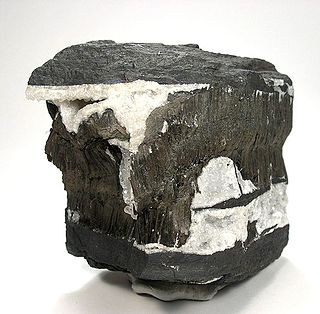
Todorokite is a rare complex hydrous manganese oxide mineral with the chemical formula (Na,Ca,K,Ba,Sr)
1-x(Mn,Mg,Al)
6O
12·3-4H
2O. It was named in 1934 for the type locality, the Todoroki mine, Hokkaido, Japan. It belongs to the prismatic class 2/m of the monoclinic crystal system, but the angle β between the a and c axes is close to 90°, making it seem orthorhombic. It is a brown to black mineral which occurs in massive or tuberose forms. It is quite soft with a Mohs hardness of 1.5, and a specific gravity of 3.49 - 3.82. It is a component of deep ocean basin manganese nodules.
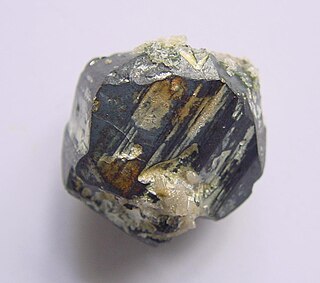
Djurleite is a copper sulfide mineral of secondary origin with formula Cu31S16 that crystallizes with monoclinic-prismatic symmetry. It is typically massive in form, but does at times develop thin tabular to prismatic crystals. It occurs with other supergene minerals such as chalcocite, covellite and digenite in the enriched zone of copper orebodies. It is a member of the chalcocite group, and very similar to chalcocite, Cu2S, in its composition and properties, but the two minerals can be distinguished from each other by x-ray powder diffraction. Intergrowths and transformations between djurleite, digenite and chalcocite are common. Many of the reported associations of digenite and djurleite, however, identified by powder diffraction, could be anilite and djurleite, as anilite transforms to digenite during grinding.

Wadsleyite is an orthorhombic mineral with the formula β-(Mg,Fe)2SiO4. It was first found in nature in the Peace River meteorite from Alberta, Canada. It is formed by a phase transformation from olivine (α-(Mg,Fe)2SiO4) under increasing pressure and eventually transforms into spinel-structured ringwoodite (γ-(Mg,Fe)2SiO4) as pressure increases further. The structure can take up a limited amount of other bivalent cations instead of magnesium, but contrary to the α and γ structures, a β structure with the sum formula Fe2SiO4 is not thermodynamically stable. Its cell parameters are approximately a = 5.7 Å, b = 11.71 Å and c = 8.24 Å.
Jarosewichite is a rare manganese arsenate mineral with formula: Mn2+3Mn3+(AsO4)(OH)6. It was first described in Franklin, New Jersey which is its only reported occurrence. Its chemical composition and structure are similar to chlorophoenicite. This mineral is orthorhombic with 2/m2/m2/m point group. Its crystals are prismatic or barrel-shaped. The color of jarosewichite is dark red to black. It has subvitreous luster of fracture surfaces and reddish-orange streak. This mineral occurs with flinkite, franklinite, andradite and cahnite.

Lavendulan is an uncommon copper arsenate mineral, known for its characteristic intense electric blue colour. It belongs to the lavendulan group, which has four members:

Tsumebite is a rare phosphate mineral named in 1912 after the locality where it was first found, the Tsumeb mine in Namibia, well known to mineral collectors for the wide range of minerals found there. Tsumebite is a compound phosphate and sulfate of lead and copper, with hydroxyl, formula Pb2Cu(PO4)(SO4)(OH). There is a similar mineral called arsentsumebite, where the phosphate group PO4 is replaced by the arsenate group AsO4, giving the formula Pb2Cu(AsO4)(SO4)(OH). Both minerals are members of the brackebuschite group.

Eveite is a manganese arsenate mineral in the olivenite group. Its chemical formula is Mn2AsO4OH. It is found only in Långban, Filipstad, Värmland, Sweden and at the Sterling Mine in New Jersey, United States. It is a dimorph of sarkinite and is isostructural with adamite. The name, for the biblical "Eve", comes from its structural similarities to adamite and is also a reference to its apple-green color. It can also be pale yellow. Eveite is an orthorhombic mineral, which means it has three crystallographic axes of unequal lengths which are at 90° to one another.
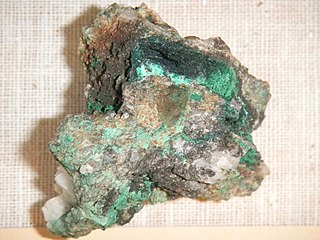
Lipscombite (Fe2+,Mn2+)(Fe3+)2(PO4)2(OH)2 is a green gray, olive green, or black. phosphate-based mineral containing iron, manganese, and iron phosphate.

Maricite or marićite is a sodium iron phosphate mineral (NaFe2+PO4), that has two metal cations connected to a phosphate tetrahedron. It is structurally similar to the much more common mineral olivine. Maricite is brittle, usually colorless to gray, and has been found in nodules within shale beds often containing other minerals.

Köttigite is a rare hydrated zinc arsenate which was discovered in 1849 and named by James Dwight Dana in 1850 in honour of Otto Friedrich Köttig (1824–1892), a German chemist from Schneeberg, Saxony, who made the first chemical analysis of the mineral. It has the formula Zn3(AsO4)2·8H2O and it is a dimorph of metaköttigite, which means that the two minerals have the same formula, but a different structure: köttigite is monoclinic and metaköttigite is triclinic. There are several minerals with similar formulae but with other cations in place of the zinc. Iron forms parasymplesite Fe2+3(AsO4)2·8H2O; cobalt forms the distinctively coloured pinkish purple mineral erythrite Co3(AsO4)2·8H2O and nickel forms annabergite Ni3(AsO4)2·8H2O. Köttigite forms series with all three of these minerals and they are all members of the vivianite group.

Carminite (PbFe3+2(AsO4)2(OH)2) is an anhydrous arsenate mineral containing hydroxyl. It is a rare secondary mineral that is structurally related to palermoite (Li2SrAl4(PO4)4(OH)4). Sewardite (CaFe3+2(AsO4)2(OH)2) is an analogue of carminite, with calcium in sewardite in place of the lead in carminite. Mawbyite is a dimorph (same formula, different structure) of carminite; mawbyite is monoclinic and carminite is orthorhombic. It has a molar mass of 639.87 g. It was discovered in 1850 and named for the characteristic carmine colour.

Serpierite (Ca(Cu,Zn)4(SO4)2(OH)6·3H2O) is a rare, sky-blue coloured hydrated sulfate mineral, often found as a post-mining product. It is a member of the devilline group, which has members aldridgeite (Cd,Ca)(Cu,Zn)4(SO4)2(OH)6·3H2O, campigliaite Cu4Mn2+(SO4)2(OH)6·4H2O, devilline CaCu4(SO4)2(OH)6·3H2O, kobyashevite Cu5(SO4)2(OH)6·4H2O, lautenthalite PbCu4(SO4)2(OH)6·3H2O and an unnamed dimorph of devilline. It is the calcium analogue of aldridgeite and it is dimorphous with orthoserpierite CaCu4(SO4)2(OH)6·3H2O.
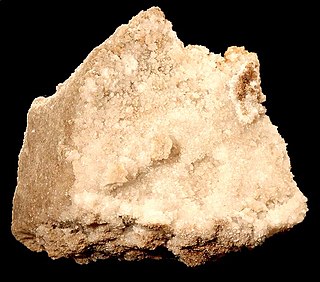
Talmessite is a hydrated calcium magnesium arsenate, often with significant amounts of cobalt or nickel. It was named in 1960 for the type locality, the Talmessi mine, Anarak district, Iran. It forms a series with β-Roselite, where cobalt replaces some of the magnesium, and with gaitite, where zinc replaces the magnesium. All these minerals are members of the fairfieldite group. Talmessite is dimorphic with wendwilsonite.
Scotlandite is a sulfite mineral first discovered in a mine at Leadhills in South Lanarkshire, Scotland, an area known to mineralogists and geologists for its wide range of different mineral species found in the veins that lie deep in the mine shafts. This specific mineral is found in the Susanna vein of Leadhills, where the crystals are formed as chisel-shaped or bladed. Scotlandite was actually the first naturally occurring sulfite, which has the ideal chemical formula of PbSO3. The mineral has been approved by the Commission on New Minerals and Mineral Names, IMA, to be named scotlandite for Scotland.
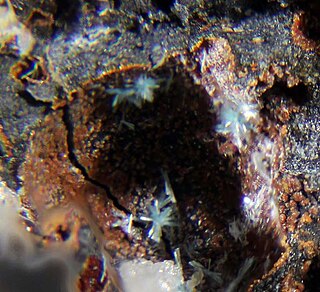
Mammothite is a mineral found in the Mammoth mine in Tiger, Arizona and also in Laurium, Attika, Greece. This mineral was named in 1985 by Donald R. Peacor, Pete J. Dunn, G. Schnorrer-Köhler, and Richard A. Bideaux, for the Mammoth vein (one of the two main veins in the mine) and the town of Mammoth, Arizona, which was named for the mine. The mammothite that is found in Arizona exist as euhedral crystals imbedded in micro granular, white colored anglesite with a saccharoidal texture. The associated minerals include phosgenite, wulfenite, leadhillite and caledonite. In Greece, the mammothite exists as small euhedral crystals and also as microscopic rock cavities lined with projecting crystals within the slags. The associated minerals here are cerussite, phosgenite and matlockite. The ideal chemical formula for mammothite is Pb6Cu4AlSb5+O2(OH)16Cl4(SO4)2.

Serrabrancaite is a mineral with the chemical formula MnPO4•H2O and which is named for the locality where it was found, the Alto Serra Branca Pegmatite. The Alto Serra Branca mine has been in operation since the 1940s. It is located in Paraiba, Brazil near a village named Pedra Lavrada. Tantalite is the main mineral mined here. Specimens of serrabrancaite are kept in the Mineralogical Collections of both the Bergakademie Freiberg, Germany and the Martin-Luther Universität Halle, Institut für Geologische Wissenschaften.

Malhmoodite is a phosphate mineral first discovered at a mine called Union Carbide in Wilson Springs, Arkansas, United States. This mine is 10 km west of Magnet Cove, an alkaline igneous complex, and Union Carbide is in a contact region of alkalic igneous rocks and surrounding sedimentary rocks. The mineral has been approved by the Commission on New Minerals and Mineral Names, IMA, to be named for the late Bertha K. Malhmood, the Administrative Assistant of the Branch of Analytical Laboratories, U.S. Geological Survey.
References
- ↑ Warr, L.N. (2021). "IMA–CNMNC approved mineral symbols". Mineralogical Magazine. 85 (3): 291–320. Bibcode:2021MinM...85..291W. doi: 10.1180/mgm.2021.43 . S2CID 235729616.
- ↑ Panethite, Webmineral.com
- ↑ Panethite, Mindat.org
- Fuchs, Louis H.(1967) On the occurrence of Brianite and Panethite, two new phosphate minerals from the Dayton meteorite. Geochimica et Cosmochimica Acta, 31, 1711-1719.
- Fuchs, Louis H. (1968) Panethite. American Mineralogist, 53, 509